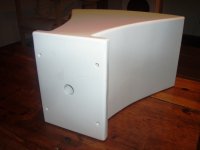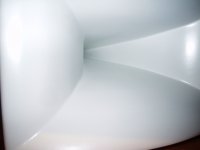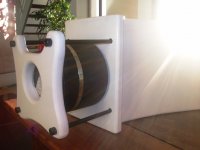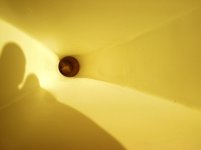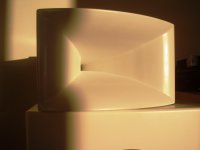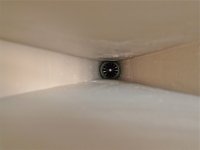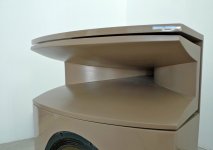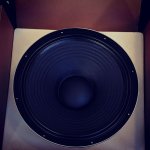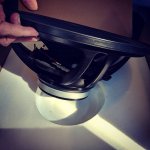These Germans build beautiful radial horns out of wood:
Home
I have not heard any of these so far.
Regards
Charles
Aesthetically pleasing, maybe.
Good design, DEFINITELY NOT.
All those horn feature extremely CRUDE and inappropriate throat adaptors: just look at the abrupt transition from round to square! No good.
What I do not understand is the original adapter. It reduces it's diameter for a 2" throat to 40mm in the vertical direction because of the rectangular opening of the horn. It is too short in my eyes. Therefore, I already showed a new adapter a few pages ago. Hopefully I will receive them soon for testing for my 1.5" drivers.
The original adapter is a very short affair that goes from 50mm round to 40x50mm rectangular over just 20mm of length. It has an almost constant cross-sectional area, and as a result an almost zero flare rate (the equivalent exponential cut-off freq. is actually 25Hz).
It was designed that way to squeeze the wavefront at the throat somewhat so as to force it to better "stick" to the sidewalls, and thus improve the horizontal directivity control of the main horn.
And in fact, combined with the internal vanes ("fins"), the TH-4001 radial horn (itself a hypex expansion with Fc = 320Hz) achieves almost constant 90º horizontal directivity from Fc up to 12kHz or so.
The trade-off is that the slight "pinching" at the throat and the vanes cause some additional diffraction, compared to a similar horn featuring a "normal" throat adapter and no vanes.
With radial horns, you pick your poison...
Marco.
The original adapter is a very short affair that goes from 50mm round to 40x50mm rectangular over just 20mm of length. It has an almost constant cross-sectional area, and as a result an almost zero flare rate (the equivalent exponential cut-off freq. is actually 25Hz).
It was designed that way to squeeze the wavefront at the throat somewhat so as to force it to better "stick" to the sidewalls, and thus improve the horizontal directivity control of the main horn.
And in fact, combined with the internal vanes ("fins"), the TH-4001 radial horn (itself a hypex expansion with Fc = 320Hz) achieves almost constant 90º horizontal directivity from Fc up to 12kHz or so.
The trade-off is that the slight "pinching" at the throat and the vanes cause some additional diffraction, compared to a similar horn featuring a "normal" throat adapter and no vanes.
With radial horns, you pick your poison...
Marco.
You may go here:
https://www.diyaudio.com/forums/mul...m-spl-low-distortion-2-a-445.html#post5981524
The trade-off is that the slight "pinching" at the throat and the vanes cause some additional diffraction, compared to a similar horn featuring a "normal" throat adapter and no vanes.
With radial horns, you pick your poison...
Marco.
This would be my preferred poison as regards these type of horns.
Attachments
Last edited:
The vanes also pinch the throat. They may or may not behave like a diffraction slot. Compared to a typical diffraction slot, their diffraction is spread across the wavefront rather than originating at the sides, and does this due to the outer edges converging rather than continuing, even virtually, as sectoral divisions.
I have considered using vanes for various unrelated reasons on occasion. For example, to produce a corner radial that could be placed further into a corner without cutting into the room walls. I don't see vanes internal to entirely conical walls as being a perfect solution to anything.
I have considered using vanes for various unrelated reasons on occasion. For example, to produce a corner radial that could be placed further into a corner without cutting into the room walls. I don't see vanes internal to entirely conical walls as being a perfect solution to anything.
This would be my preferred poison as regards these type of horns.
Yeah, those look like good ones. As, IMHO, do Joseph Crowe's, and (perhaps to a slightly less optimised extent) Yuichi Arai's "fin-less" ones.
Which horns are those? Are they commercially available?
If I went for the Yuichi style horn, should I not use the fins? I thought they were a necessary part of the design to prevent too much beaming.
If I went for the Yuichi style horn, should I not use the fins? I thought they were a necessary part of the design to prevent too much beaming.
Mr. Arai designed both types of horns : with and without the fins. Pros and cons to each.
But of course, no, you can't just remove the fins willy nilly from a design that originally had them. The whole horn expansion profile needs to be redesigned ad hoc.
Marco
The white horns are diy, based on the drawings of "Pavillon Iwata en tranches" by J. Ledauphin published in Audiophile n°25, septembre 1982.
A similar, albeit truncated horn, based on a sligthly modified version of JMLC's IWATA calculations is Astos' Bi-Radial JMLC-IWATA.
This horn provides better directivity, due to it's limited length and curvature. The white horns' cut off is considerably lower.
It's indeed a question of "pick your poison".
A similar, albeit truncated horn, based on a sligthly modified version of JMLC's IWATA calculations is Astos' Bi-Radial JMLC-IWATA.
This horn provides better directivity, due to it's limited length and curvature. The white horns' cut off is considerably lower.
It's indeed a question of "pick your poison".
Attachments
-
 Vattenfall_zpsb2afb135.jpg86.1 KB · Views: 166
Vattenfall_zpsb2afb135.jpg86.1 KB · Views: 166 -
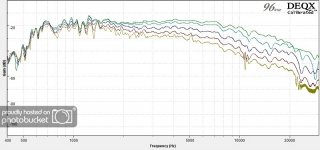 Spridning biradial jmlc_zpsynhea9go.jpg159.2 KB · Views: 182
Spridning biradial jmlc_zpsynhea9go.jpg159.2 KB · Views: 182 -
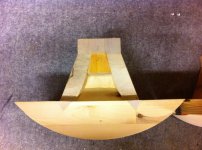 ED8D87B0-22C2-4AEC-B87C-690D50AD0459-4951-00000798C2FC9180.jpg88.5 KB · Views: 159
ED8D87B0-22C2-4AEC-B87C-690D50AD0459-4951-00000798C2FC9180.jpg88.5 KB · Views: 159 -
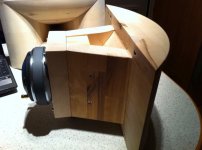 6A123665-AF25-43E9-8D07-AC30334B944A-4951-00000798C9D12660.jpg54.4 KB · Views: 158
6A123665-AF25-43E9-8D07-AC30334B944A-4951-00000798C9D12660.jpg54.4 KB · Views: 158 -
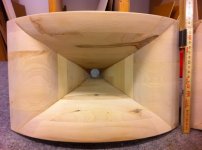 8F16B991-E8C0-4253-B58C-EB4078CA3995-4951-00000798CEBBDC65.jpg55.6 KB · Views: 180
8F16B991-E8C0-4253-B58C-EB4078CA3995-4951-00000798CEBBDC65.jpg55.6 KB · Views: 180
Last edited:
Less well known outside the EU are the IWATA variations developed by Jean-Francois Guigue. He was also a member of the groundbreaking l'Audiophile scene in Paris.
JMLC obviously took inspiration from Guigue in development of his IWATA-JMLC horns.
Attached are some images of the Guigue C200 that can be used from 300-19000 Hz in a 2-way system.
The TAD 2003 drivers are usually specifically modified for this horn.
The horns are made on a mold with special fiber plaster, plywood and wood. The hollow space between the double walls is filled with a special ultra fine ceramic sand.
Dimensions:
Depth: 74 cm, without TAD 4003
Width: 68 cm
Height: 26 cm
Audible Cut off: 145 Hz
Horn entry 1.4 inch diameter
The weight is about 35 kg per horn without driver.
JMLC obviously took inspiration from Guigue in development of his IWATA-JMLC horns.
Attached are some images of the Guigue C200 that can be used from 300-19000 Hz in a 2-way system.
The TAD 2003 drivers are usually specifically modified for this horn.
The horns are made on a mold with special fiber plaster, plywood and wood. The hollow space between the double walls is filled with a special ultra fine ceramic sand.
Dimensions:
Depth: 74 cm, without TAD 4003
Width: 68 cm
Height: 26 cm
Audible Cut off: 145 Hz
Horn entry 1.4 inch diameter
The weight is about 35 kg per horn without driver.
Attachments
Images of the B&C DCX464's innards have been released, so I might as well post some.
Attachments
-
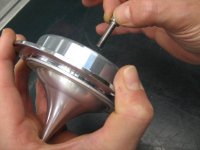 Cambio MBR DCX 464 023.jpg80.7 KB · Views: 184
Cambio MBR DCX 464 023.jpg80.7 KB · Views: 184 -
 Cambio MBR DCX 464 022.jpg84.3 KB · Views: 183
Cambio MBR DCX 464 022.jpg84.3 KB · Views: 183 -
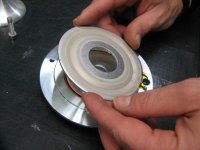 Cambio MBR DCX 464 019.jpg86.6 KB · Views: 183
Cambio MBR DCX 464 019.jpg86.6 KB · Views: 183 -
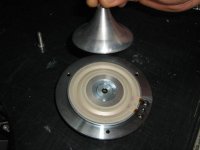 Cambio MBR DCX 464 018.jpg66.7 KB · Views: 480
Cambio MBR DCX 464 018.jpg66.7 KB · Views: 480 -
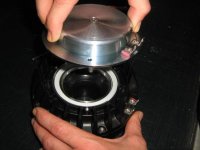 Cambio MBR DCX 464 016.jpg76.9 KB · Views: 478
Cambio MBR DCX 464 016.jpg76.9 KB · Views: 478 -
 Cambio MBR DCX 464 008.jpg101.5 KB · Views: 501
Cambio MBR DCX 464 008.jpg101.5 KB · Views: 501 -
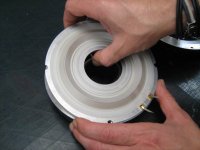 Cambio MBR DCX 464 007.jpg78.8 KB · Views: 489
Cambio MBR DCX 464 007.jpg78.8 KB · Views: 489 -
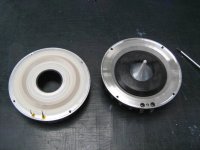 Cambio MBR DCX 464 005.jpg85.3 KB · Views: 490
Cambio MBR DCX 464 005.jpg85.3 KB · Views: 490 -
 Cambio MBR DCX 464 001 (1).jpg71.7 KB · Views: 177
Cambio MBR DCX 464 001 (1).jpg71.7 KB · Views: 177 -
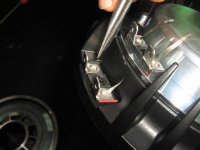 Cambio MBR DCX 464 009.jpg81.9 KB · Views: 180
Cambio MBR DCX 464 009.jpg81.9 KB · Views: 180
Last edited:
Plz don't insult the people who are carrying this thread currently. I appreciate what they are doing as I do understand the humbleness of their gratitude, never rush a good thing 😉
In which universe do you reside in? I'm responding to you, I'm amazed about the help you get by all others. And all you do is ask for more without any effort from you??
Images of the B&C DCX464's innards have been released, so I might as well post some.
You should not touch the unplated internal parts without a pair of gloves unless you want to see your loudspeaker driver units rotting by the inside.
Good tip silversprout!
A few months ago a major revision of the venerable Strauss SE-MF-2 large format monitor was announced.
Attached is the successor to the TAD 1601.
Initially it looks like a 18Sound or B&C, but it isn't. At least the cone, spider and chassis are different.
The cone is a typical (mid)woofer cone with 5 ribs and m-roll surround, similar to the RCF L15P530.
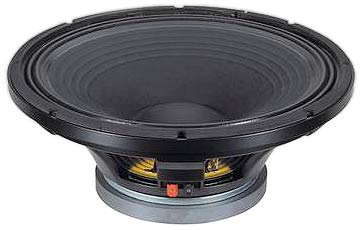
The spider is probably customized by Kurt Müller and the chassis is a catalog item from one of the world's biggest component manufacturers.
A few months ago a major revision of the venerable Strauss SE-MF-2 large format monitor was announced.
Attached is the successor to the TAD 1601.
Initially it looks like a 18Sound or B&C, but it isn't. At least the cone, spider and chassis are different.
The cone is a typical (mid)woofer cone with 5 ribs and m-roll surround, similar to the RCF L15P530.

The spider is probably customized by Kurt Müller and the chassis is a catalog item from one of the world's biggest component manufacturers.
Attachments
Last edited:
In which universe do you reside in? I'm responding to you, I'm amazed about the help you get by all others. And all you do is ask for more without any effort from you??
Peter, why take this attitude?
camplo explicitly expressed gratitude several times throughout his thread.
Last edited:
An Asian electro-magician made a compression driver based on a WE594A clone as well as a defective original. It took a whole month to complete the programming of the CNC lathe. The motor parts, coil and diaphragm were sourced in the USA.
The driver weighs an impressive 15kg. The outer parts are machined out of high quality steel and the back plate is carved from solid aluminum alloy.
The gap is only about 1mm to ensure a high magnetic flux density.
An excitation guide and indentations are machined to further enhance the density of magnetic flux.
The 101mm aluminum diaphragm features rounded edges, which is different from Altec's diamond edge.
Unfortunately no measurement data is available, but according to the maker it easily beats the TAD4001, especially on vocals.
Even without horn, the driver takes a crossover of 600Hz and reaches 22kHz.
Check the huge Kinoshita monitor behind the plastic chair.
The driver weighs an impressive 15kg. The outer parts are machined out of high quality steel and the back plate is carved from solid aluminum alloy.
The gap is only about 1mm to ensure a high magnetic flux density.
An excitation guide and indentations are machined to further enhance the density of magnetic flux.
The 101mm aluminum diaphragm features rounded edges, which is different from Altec's diamond edge.
Unfortunately no measurement data is available, but according to the maker it easily beats the TAD4001, especially on vocals.
Even without horn, the driver takes a crossover of 600Hz and reaches 22kHz.
Check the huge Kinoshita monitor behind the plastic chair.
Attachments
-
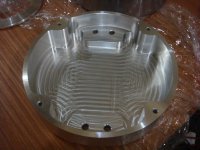 1051292671_o.jpg428.4 KB · Views: 171
1051292671_o.jpg428.4 KB · Views: 171 -
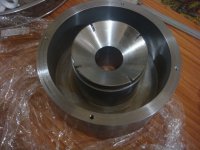 1051292959_o.jpg436.4 KB · Views: 154
1051292959_o.jpg436.4 KB · Views: 154 -
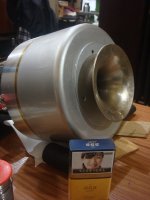 1057008439_o.jpg358.2 KB · Views: 154
1057008439_o.jpg358.2 KB · Views: 154 -
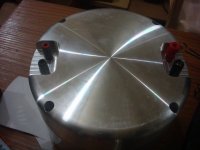 1057013794_o.jpg339.4 KB · Views: 141
1057013794_o.jpg339.4 KB · Views: 141 -
 1057009165_o.jpg316.3 KB · Views: 142
1057009165_o.jpg316.3 KB · Views: 142 -
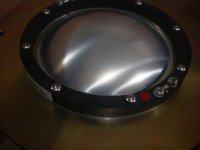 1057008437_o.jpg322 KB · Views: 147
1057008437_o.jpg322 KB · Views: 147 -
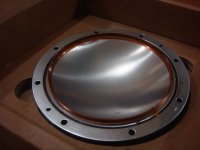 1051292169_o.jpg389.2 KB · Views: 159
1051292169_o.jpg389.2 KB · Views: 159 -
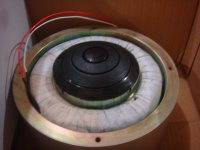 1057008438_o.jpg342.4 KB · Views: 155
1057008438_o.jpg342.4 KB · Views: 155 -
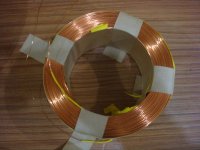 1053136867_o.jpg433.7 KB · Views: 161
1053136867_o.jpg433.7 KB · Views: 161 -
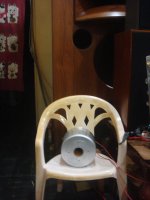 1057015424_o.jpg345.5 KB · Views: 192
1057015424_o.jpg345.5 KB · Views: 192
Last edited:
Joseph Crowe's ES-290 Zebra Horn:
An externally hosted image should be here but it was not working when we last tested it.
Check the huge Kinoshita monitor behind the plastic chair.
They are not huge - they are just large ! 😉
Regards
Charles
Good tip silversprout!
A few months ago a major revision of the venerable Strauss SE-MF-2 large format monitor was announced.
Attached is the successor to the TAD 1601.
...
Nice woofer.
The chassis looks like a simpler version of the one used by Fostex in their latest 40cm woofers (FW405N and W400A-HR, both now sadly discontinued).
Overall, probably a nice woofer, though I'm not sure it will be any "better" in any meaningful way than the venerable TAD TL-1601a/b. But most likely it'll be cheaper for Müller to purchase, which of course makes good business sense, provided that it´s still "good enough".
In other words... it looks suspiciously like the age-old practice of "cutting corners" to me, while pretending that it's done for the purpose of "improving" the product.
Come up with a bit of fancy marketing-speak, slap a "mk II" at the end of the product name... et voilà, job done! ;-)
M.
- Home
- Loudspeakers
- Multi-Way
- Is it possible to cover the whole spectrum, high SPL, low distortion with a 2-way?

